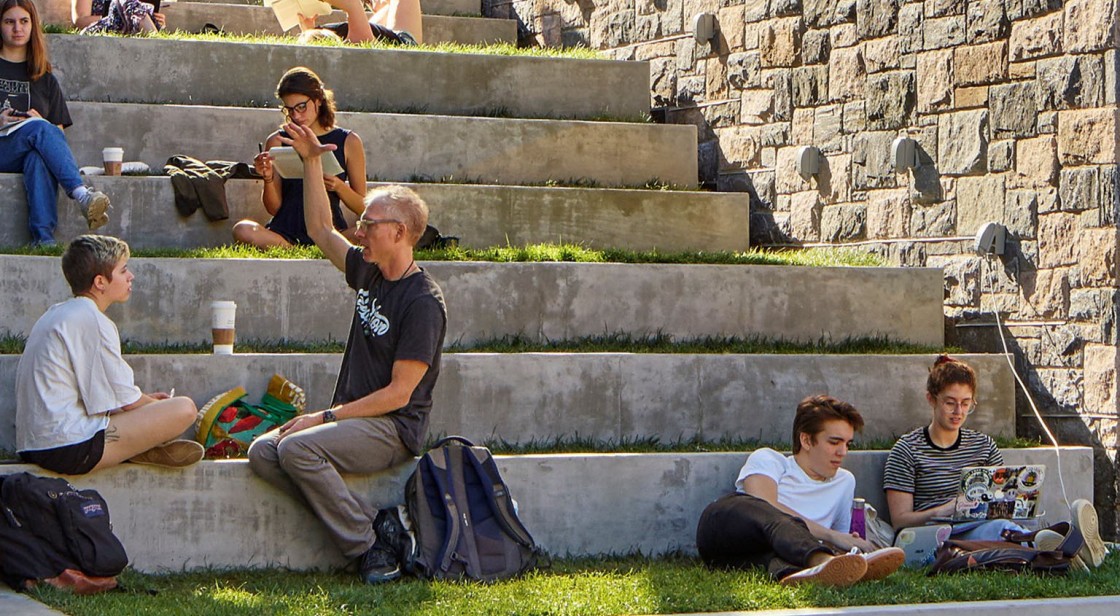Historically, social, political, and economic forces have shaped our built environments. Crises, from natural disasters to economic collapses have forced changes to the built environment, both evolutionary and revolutionary. COVID-19 is a catalyst of such change. Several evolving architecture and design trends have not only been validated but accelerated to meet this moment: the value of open space, empathy, the balance of convergence and decentralization, blending boundaries, and wellness.
KSS leaders Mayva Donnon, AIA and Jason Chmura, AIA shared their insights on these trends with fellow members of ULI NEXT Philadelphia, a council of Urban Land Institute members who are emerging as leaders in development and the built environment, at a recent council meeting. These ideas extend across typologies and markets and will influence how designers approach spaces from academic learning environments to workplaces to distribution centers, and more.
VALUE OF OPEN SPACE
A common theme across all space typologies, the value of open space has become particularly salient in the era of coronavirus. With health and safety guidelines rendering many indoor spaces such as offices, arenas, and classrooms unsafe for the time being (at least without modifications), open spaces present tremendous value. Open outdoor spaces offer opportunities for distanced socializing and recreation, respite and relaxation, and connection with nature. Moving forward, we expect clients to place greater emphasis on outdoor space, as well as open indoor spaces, across all markets.
EMPATHY
While in-person collaboration is the most compelling reason for knowledge workers to return to the office, those re-entering the workplace experience barriers to typical interpersonal communication due to mask wearing and physical distancing. Tools for virtual connection such as Zoom have their own barriers including a split-second delay that creates a communication lag, making the brain work harder to comprehend what someone is communicating, in addition to lack of in-person eye contact and body language. In both in-person and virtual settings, fostering empathy for one another—practicing compassion and understanding for the collective and individual challenges each of us is facing—can help us break through these barriers to communication. From our point of view as designers, this trend reminds us to ensure that we exercise empathy and respect for humanity as we craft spaces for people to inhabit.
CONVERGENCE + DECENTRALIZATION
In recent years, we have seen space typologies converge as activities become more decentralized or distributed. While it may seem paradoxical at first, it makes sense that multifunctional spaces that can accommodate a variety of activities offer great value, especially as compared to dedicated spaces designed to accomplish one specific task. Higher education has operated according to this model for years, wherein autonomous independent work occurs in any number of flexible environments from a dorm room to a local coffee shop and specialized spaces exist for synchronous learning and collaboration or for activities that require it, such as laboratory research. With many institutions and workplaces scrambling to accommodate physical distancing and reduce density, this trend has been accelerated due to the flexibility it allows. Moving forward, the value of specialized spaces will likely be in question in favor of multipurpose spaces that can nimbly shift focus.
BLENDING BOUNDARIES
As technology has advanced over the past few decades, boundaries between home, school, and work have become increasingly blurred. Now more than six months into a global pandemic, those boundaries have all but disappeared for many as homes have transitioned to function as offices and classrooms, in addition to being places of refuge and relaxation. Designers and developers will need to reconsider the full spectrum of activities that may happen in a space, one that likely includes a wider variety than it may have prior to COVID-19. For example, we have seen multifamily developers increasing unit sizes, adding enough square footage to accommodate working and learning from home. In higher education, the trend toward more student life space integrated into housing will only continue as these spaces have proven their value through their ability to flexibly function as academic space, too.
WELLNESS
Emphasis on holistic wellness has accelerated faster than perhaps any other trend because of COVID-19. The established practice of sustainability certification, which has broadened in in recent years to include human experience in addition to building performance, is surging like never before. Since the pandemic began in early 2020, the International WELL Building Institute has welcomed one million-square-feet per day in pursuit of certification. Sustainability frameworks including LEED and WELL will not only increase in popularity, but in added value, and across all markets. For example, with the rise of e-commerce and subsequent increase in industrial development, distribution centers and logistics hubs are the workplace for a significant amount of the workforce yet working conditions have come under fire. Implementing wellness strategies that increase employee health and wellbeing will add value to industrial development, lowering turnover, increasing employee satisfaction, and even increasing employee performance.
DESIGN FOR HUMANITY
The crisis of COVID-19 has exposed and accelerated the trajectory of trends that add value to the built environment. A common thread that runs through each is renewed focus on design that serves humanity, whether that be through spaces that engender empathy, offer flexibility for a changing world, or improve the health and wellbeing of those utilizing them. While this time has brought undeniable tragedy, it has also offered a welcome reminder to put people first.

